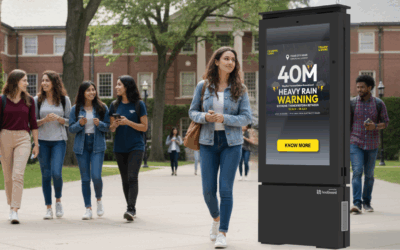The Attention Economy Has Changed the Rules
Once upon a time, visibility was everything. If your ad reached millions of eyes through TV, print, or billboards, success followed. But in today’s fragmented digital world, attention — not exposure — is the real currency.
We live in an era where the average consumer sees over 10,000 marketing messages per day, and only engages meaningfully with a handful. In 2024, global spending on traditional advertising fell 2% to $403 billion, while digital, interactive, and experiential formats grew over 10% year-on-year.
The problem isn’t advertising itself — it’s passive advertising.
Modern travelers scroll, swipe, skip, and ignore. Traditional ads shout louder; interactive touchpoints listen better.

Why Static Ads Are Losing the Tourism Battle
For decades, tourism boards, hotels, and attractions relied on print brochures, outdoor hoardings, and broadcast media. But three structural shifts have eroded their effectiveness:
a. Ad Fatigue and Banner Blindness
TV viewers skip commercials. Online users block banners. Travelers no longer pause to look at wall posters unless they solve an immediate problem.
b. Attribution Black Hole
How do you measure ROI from a street banner? Or a magazine ad? Attribution is almost impossible — while kiosk interactions offer real-time click, dwell-time, and booking data.
c. Generic Messaging
A family of four and a solo backpacker see the same airport poster — yet their needs are entirely different. That’s wasted relevance, and wasted spend.
In short: traditional ads broadcast to everyone but connect with no one.

Enter the Interactive Kiosk: A New Kind of Media Channel
At airports, hotel lobbies, and destination centers, interactive kiosks have quietly become the most efficient way to capture traveler attention — right at the moment of intent.
Unlike static ads that depend on interruption, kiosks rely on invitation. They’re where travelers want to know “What’s nearby?,” “Where to eat?,” or “What’s happening tonight?” — and are open to discovering offers.
The Contextual Advantage
Every ad on a kiosk is relevant to time, place, and traveler intent.
- A café ad shows at breakfast hours.
- A tour promotion pops up near a cruise terminal.
- A city event banner appears during festival weekends.
This contextuality multiplies conversion rates.

The Economics Behind It: Where the Money Flows
Let’s break down how interactive kiosks monetize attention while traditional ads simply drain budgets.
| Revenue Stream | How It Works | Example |
| Sponsored Listings | Local merchants pay to appear first in search results. | A restaurant pays $150/month for “featured dining” placement. |
| Digital Ad Slots (CPM) | Rotating banners, videos, or interactive promos sold per impression. | City tourism board advertises events; hotel chain sponsors screen backgrounds. |
| Booking Commissions | Partner services (tours, cabs, tickets) share % of completed sales. | 10% cut on every booking made through the kiosk. |
| Data Monetization | Anonymous analytics on traveler preferences and footfall. | Visitor board gains insight on what tourists search for most. |
| Subscription / SaaS Access | Businesses subscribe monthly for dashboard listings. | Local attractions pay $50/month for digital presence. |
Unlike TV or print, each of these streams is trackable, repeatable, and scalable.

The Market Is Moving: Numbers Don’t Lie
- Interactive kiosk market size (2024): $34.7 B
- Projected (2030): $52.7 B (7% CAGR)
- Average ROI: Payback within 18–30 months (industry benchmark)
- Traditional ad ROI decline: Down ~12% since 2020
In tourism, where physical presence still matters, kiosks bridge the online–offline divide — offering visibility and measurability.
For example, a hotel kiosk with 1,000 monthly users can earn:
- $500 in promoted listings
- $1,000 in ad inventory CPM
$500 in booking commissions
→ $2,000 in monthly revenue, with network effects compounding as footfall increases.

The Tourism Use Cases: From Airports to Alley Cafés
| Environment | Purpose | Who Pays | Value |
| Airports / Transit Hubs | Wayfinding + Offers | Airlines, car rentals, tour operators | Last-mile conversions |
| Hotel Lobbies | Local discovery, upsells | Restaurants, spas, attractions | Guest experience + new revenue |
| Visitor Centers / DMOs | City-wide promotion | Local merchants, events | Destination intelligence |
| Cruise / Ferry Terminals | Scheduling, maps | Transport, retail | Cross-selling in transit |
| Museums & Attractions | Ticketing, memberships | Sponsors, souvenir vendors | In-venue monetization |
Kiosks are not “just digital signage.” They’re revenue-generating micro-media ecosystems — one that scales city-wide when networked.
Why DMOs and Hotels Love the Data
In a post-cookie world, first-party insights matter. Every kiosk tap, dwell time, and category selection tells a story about traveler interests — what’s trending, where visitors are from, and what they’re most likely to do next.
Hotels use this to refine packages. DMOs use it to design better campaigns. Attractions use it to predict demand.
It’s not advertising data — it’s destination intelligence.

Designing for Revenue & Experience (UX Brief for Tourism Kiosks)
To truly capture attention, form and function must align.
Key design rules:
- Utility First: 70% useful content, 30% promotional.
- Dynamic Context: Time-based, location-based ad switching.
- Minimal Touch Friction: Three-tap rule to reach desired info.
- Visual Hierarchy: “Featured” listings distinct but not intrusive.
- Consent-Driven Analytics: Always opt-in for personalized recommendations.
Every pixel should feel like hospitality, not advertising.

Scaling the Network: From One Kiosk to Citywide Ecosystems
Imagine a destination where every hotel, attraction, and transport hub runs a unified interactive system — one network, shared data, consistent visitor experience.
This is where the economics multiply:
- DMOs earn from ad networks.
- Hotels participate in revenue share.
- Visitors get seamless discovery and booking.
It’s the same flywheel that made Google Maps and TripAdvisor valuable — contextual intent → discovery → transaction → data → optimization.
Except this happens in real life.

Risks & Realities
No transformation is without friction:
- CapEx costs: Good hardware and enclosures matter.
- Content freshness: Needs regular updates to stay relevant.
- Partner onboarding: Local buy-in is crucial for sustained monetization.
- Privacy & compliance: GDPR/CCPA adherence is mandatory.
But none of these are deal-breakers — they’re design parameters. The difference lies in execution and network scale.
The Future: AI, Personalization & Hybrid Monetization
As AI enters the mix, kiosks evolve beyond static menus to conversational concierges.
- AI agents can greet visitors, recommend personalized itineraries, and even make bookings.
- Dynamic pricing can adjust ad rates in real time based on footfall and dwell time.
- Predictive analytics can help DMOs plan events where visitor interest peaks.
This convergence of AI + interactivity + location data is why analysts project interactive media to be one of the fastest-growing tourism tech sectors of the decade.

Attention Is the New Currency
In travel, attention is more than awareness — it’s action in motion.
Every second a traveler spends looking, touching, or exploring through your kiosk is a monetizable, measurable moment.
Traditional ads rent attention.
Interactive kiosks earn it.
For DMOs and hotels, the opportunity isn’t just to modernize visitor information — it’s to reclaim the economics of attention, one screen at a time.




